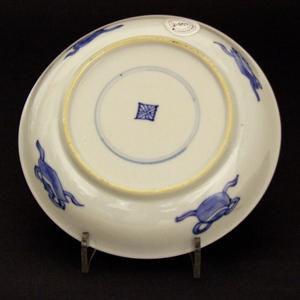
KANGXI 1662 -1722. Chinese Export Porcelain
A Kangxi European Subject Blue and White Porcelain Saucer c.1690-1700. The Central Roundel Depicts a King and Queen in Full Royal Regalia on a Throne, Traditionally Said to be Queen Blanche of Castile and Louis IX of France. The Ten Panels that Radiate from the Roundel are Painted in a Loser Style with a Kneeling Chinese Man, Apparently Giving Homage. These Panels Alternate with Panels of a Shrub or Tree.
SOLD
- Condition
- Perfect.
- Size
- 13.5 cm (5 1/4 inches)
- Provenance
- N/A
- Stock number
- 21599
- References
- References : For a beaker and cover of this design see : Histoire Artistique, Industrielle et Commerciale de la Porcelain (Albert Jacquemart & Edmond le Blant, J. Techener 1862). For a Kangxi cover from this lot see : Porcelain From The Vung Tau Wreck, The Hallstrom Excavation (Christian J.A. Jorg and Michael Fletcher published by Sun Tree Publishing Ltd. ISBN 981-04-5208-X) Page 60 fig.40. A pair of beakers, cover and saucer of this design are on display in The Victoria and Albert Museum London, room 136, cabinet 4, shelf 7, item 40. For three Kangxi beaker covers of this pattern see R & G McPherson Antiques stock numbers 21843, 21844, 21845 these came from : The Vung Tau Cargo, Chinese Export Porcelain. Christie`s Amsterdam, 7th and 8th of April 1992. Lot 856, 25 covers in total (this was the only lot with this design).
Information
An Early Chine de Commande Design:
This pattern is traditionally said to represent Blanche of Castile (1188 – 1252), wife of Louis VIII of France with her son Louis IX (1214 – 1270). Louis IX was King of France from 1226 until his death. He was also styled Louis II, Count of Artois from 1226 to 1237 but is best known in France as Saint Louis. The central design is clearly taken from a European copper-plate engraving which has yet to be identified, the beakers of this pattern are inscribed in French "l`Empire de la vertue est etabli jusq`au bout de l`univers" (The kingdom of virtue is established up to the borders of the universe). This inscription is also yet to be identified, but is presumably present on the original source engraving. The Chinese figures around the central design represent even more of a mystery. They are painted in a looser style and do not show the cross-hatching of the central design, so it is possible these figures were not taken from a European engraving. Maybe the Chinese artist wanted to show figures that were reverential to the royal figures in the center or perhaps they are indeed after an engraving but just given a loser interpretation. I think it is true to say that this design only appears on coffee-beaker and saucers, the only examples recovered from the Vung Tau Cargo of c.1690-1700 were 25 covers. Christian Jorg talks at length about them in his excellent book `Porcelain From The Vung Tau Wreck` (see reference below) he shows that these early Chine de Commande pieces might well have been made for the Dutch market despite appearances to the contrary ; "The claim that because of the inscription these pieces were specially ordered for the French market is not necessarily true. French was the language of Dutch politicians, literati and scholars at the time and was widely spoken..."


